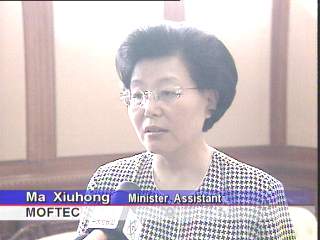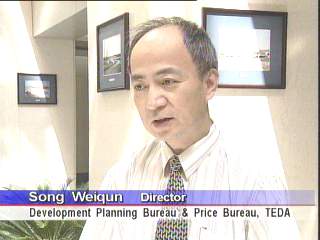 Recently, a forum was held in TTianjin's Economic Technology Development Area ianjin's Economic Technology Development Area about the development strategy of China's technology in the new century. After 17 years of development, TEDA is now home to more than 3000 foreign-funded enterprises, including some Fortune 500 companies In the next five years, some economic and technology zones have set the ambitious targets to double their output.
Recently, a forum was held in TTianjin's Economic Technology Development Area ianjin's Economic Technology Development Area about the development strategy of China's technology in the new century. After 17 years of development, TEDA is now home to more than 3000 foreign-funded enterprises, including some Fortune 500 companies In the next five years, some economic and technology zones have set the ambitious targets to double their output.
Economic and Technology Areas first appeared in China in the 1980s. In these areas, foreign-funded enterprises have access to a comfortable business environment and more importantly, preferential policies. Today however, foreign businesses in China can enjoy preferential policies no matter where they are located. Given this change, attracting more foreign businesses has become the major challenge for economic and technology development areas today.
 On August 21, a forum was held in Tianjin's Economic-technology Development Area on the development strategy of such areas in the new century. At the forum, it was agreed that the development areas should shift the focus of their work from attracting foreign investment to digesting and absorbing foreign investment, from emphasizing policy advantages to improving general environment, and from stressing quantity to quality of foreign investment used. Ma Xiuhong , Minister Assistant of MOFTEC, said:"I feel that if these transitions are successfully realized, there's a good chance that these areas will be able to improve their investment environment and economic roles."
On August 21, a forum was held in Tianjin's Economic-technology Development Area on the development strategy of such areas in the new century. At the forum, it was agreed that the development areas should shift the focus of their work from attracting foreign investment to digesting and absorbing foreign investment, from emphasizing policy advantages to improving general environment, and from stressing quantity to quality of foreign investment used. Ma Xiuhong , Minister Assistant of MOFTEC, said:"I feel that if these transitions are successfully realized, there's a good chance that these areas will be able to improve their investment environment and economic roles."
TEDA was one of the biggest and most successful economic and technology development areas in China. Established in 1984 on the shore of the Bohai Sea, some 60 kilometers away from Tianjin, TEDA has three sub-areas: the Sun Yat-Sen Scientific Industrial Park, the Chemical Park and the Microelectronics Industrial Park. In 17 years, TEDA has contracted foreign investment at an average annual growth rate of 100%. So far, it has approved 3300 foreign-funded enterprises, of which 216 involved over 10 million dollars.
Li Yong, Director of TEDA Administrative Committee, said:"Tianjin is an old industrial city in China. It has some advantages in industrial conditions, scientific and technical talent support, and labor supply. Meanwhile, our cost of land, labor, water, power, gas, and heat are lower than other places."
 Song Weiqun , Director of Development Planning Bureau & Price Bureau, TEDA, said:"Investment in TEDA shows several trends. One is that more and more enterprises are increasing their investment here. In the years I've worked here, there are more and more large projects in the area. The average scale of each project has been growing. Another tendency is the upgrade in enterprises' technologies, and the shift toward high-tech industries."
Song Weiqun , Director of Development Planning Bureau & Price Bureau, TEDA, said:"Investment in TEDA shows several trends. One is that more and more enterprises are increasing their investment here. In the years I've worked here, there are more and more large projects in the area. The average scale of each project has been growing. Another tendency is the upgrade in enterprises' technologies, and the shift toward high-tech industries."
TEDA has developed complete and advanced infrastructure facilities, including water plants, power transmission station, heating plants, and two large bridges. To service people who work and live at TEDA, a international schools, from kindergarten to post-doctorate education, have been set up as well. TEDA also prepares parks, shops, hotels, villas and apartments for its employees and residents. But environmental attention goes beyond that, as all sewage is treated before it is discharged.
Li Yong, Director of Administrative Commission of TEDA, said: "On TEDA's tenth birthday, we set a target to change TEDA from a pure industrial area into a modern industrial urban area. Now, in the new century, an era of rapid development in science and technology and knowledge economy, we have established the strategy of boosting TEDA's development with science and education."
To offer better services to TEDA companies, the administrative committee has changed its role from administrating to servicing enterprises. Administration is all available on-line, as a way of making service efficient and modern. TEDA enterprises can process all government and taxation procedures on the first floor of the Investment Service Center's office building, and access purchasing power, gas, water, telecommunications, and even banking and notary services.
 Fang Dahai , Vice Director of Economic Development Bureau, TEDA ,said: "Our growth was first slow, then fast, then at rocket speed. Now development is growing at a steady rapid pace. TEDA's GDP grew 21% last year. The expected growth rate for this year is 22%."
Fang Dahai , Vice Director of Economic Development Bureau, TEDA ,said: "Our growth was first slow, then fast, then at rocket speed. Now development is growing at a steady rapid pace. TEDA's GDP grew 21% last year. The expected growth rate for this year is 22%."
TEDA’s sound investment environment is reflected in the success of its enterprises. The excellent local investment environment has made many enterprises increase their investments here many times over. One example is Motorola.
At the beginning, Motorola only pledged to invest 0.3 million US dollars. But after several supplementary investments, its total investment in TEDA has reached 3 billion US dollars. This has made Motorola the foreign enterprise with the largest investment in China and TEDA one of the biggest semiconductor chip production centers and communications product manufacturing bases in China.
Jenny Wang, Vice President of Motorola Inc., said: "I think we made the right decision. Since 1992, we've felt strongly about our friendship and partnership with Tianjin. The people in Tianjin and TEDA are particularly business-oriented. They have very good business minds to work. They treat us like partners and really understand our business. They do everything they can do to be a true partner. And I think to do business in China, you do need a partner like Tianjin."
Established in April 1993, Tianjin Samsung Electronics Company began production just two months later. With an original production capacity of 0.6 million video recorders, the company can now produce 3.5 million video recorders in one year. And now it has begun the production of DVD players as well. Since 1998, it began exporting all of its products. Its remarkable success has made the Korean company decide to invest even more here.
Caption: TSEC's Export1999 US$ 130 m2000 US$ 160 m2001(est.) US$ 250 m
Li Shaokang , Deputy General Manager of Tianjin Samsung Electronics Co. Ltd., said: "Our company was established here in 1993, because of the area's sound development and because we liked the local conditions here. So the Korean Samsung Group decided to build a Samsung industrial base in Tianjin. After these years of development Samsung Electronics alone has 10 enterprises in Tianjin."
Last year, high-tech products accounted for more than half of TEDA’s exports. To further boost high-tech development, TEDA established an industrial incubator. Tianjin Huazhi Computer Application Company was established just last year. Its products can help doctors focus in more precisely during cerebral surgery and improve surgical safety and efficiency. The 72,000 US dollars of VC startup as well as various support received from TEDA have helped the company take off fast. Guang Wei, President of Tianjin Huazhi Computer Application Company,said: "We are the first company to use venture capital from TEDA. With the funds, our company soon passed the pre-phase period. The funding support helps us solve small business' biggest problem of getting through the startup period. Without such help, the process would've been very, very long and we might not have survived it."
So far, there have been 171 Taiwan-funded enterprises in TEDA. Tianjin Tong Yee Industrial Company is one of them. The joint Japan-Taiwan venture produces car batteries. Unlike Tianjin Samsung, Tianjin Tong Yee was attracted to TEDA mainly because of the large Chinese market and TEDA’s convenient railway, highway, and waterborne transport conditions. Now, Tianjin Tong Yee sells 95% of its products in China. Taichiro Kato , Vice President of Tianjin Tong Yee Industrial Co., Ltd., said: "Why did we choose to invest in TEDA? TEDA's environment and preferential policies for foreign enterprises are attractive. So we came here. Now looking back at our development here, we know we made the right choice.
China's economic and technology development areas were first set up in coastal areas. In 2000, with the development of China's western regions, another 11 economic and technology areas were given approval to be set up in central and western China, and following their establishment, there will be a total of 47 economic and technology areas in China.
Shanghai's Pudong New Area and Suzhou's jointly-funded Sino-Singapore Industrial Park are two areas that also enjoy the policies and practices of national economic and technology development areas. It accounts for one fourth of foreign and domestic investment in Shanghai, and contributes more than one third of Shanghai’s imports and exports. 120 Fortune 500 companies have based their China headquarters, and even Asia-Pacific headquarters in Pudong.
Wang Ande , Vice Director of Shanghai Pudong New Area People’s Government, said: "We will continue to focus on the improvement of local investment to maintain our rapid development. We estimate that our GDP will double by 2005 to reach around 24 billion US dollars."
As for the development during the next five years, TEDA has set an average annual growth target of 20%. Pudong New Area and Nanning Economic and Technology Development Area said that their targets will double their total output during this period. Kunshan Economic and Technology Development Area, with the most Taiwanese investment, announced its ambitious plan of building itself into a national IT base. He Zhong, Vice Director of Nanning Economic & Technological Development Area ,said: "In the tenth five-year plan period, we will exert ourselves to help maintain fast development and try to double our foreign investment, industrial output and GDP."
Huang Chengyi, Senior Policy official of Kunshan Economic & Technical Development Zone, said: "Now our competition for overseas investment has evolved into an environment competition. The economic and technology development area with the best environment, the best services, and the highest investment return rate will have the best chance to succeed."
Another factor the economic and technology areas should pay attention to is how to get the most attractive conditions for foreign investment. Working alongside multinationals will allow them to better boost domestic enterprise and local economy.
Mao Yushi, Senior Research Fellow of Unirule Institute of Economics , said: "In the future, in foreign fund introduction, more emphasis should be on utilizing technologies, information, and management of foreign-funded projects, instead of their capital. China is not short of money."
Where these development areas' advantages lie is in their abundant experience in servicing enterprises, high efficiency, and extensive infrastructure and facilities. To maintain their attractiveness to overseas and domestic investors and realize their ambitious development plans, the development areas need to further sharpen their competitive edge.
|